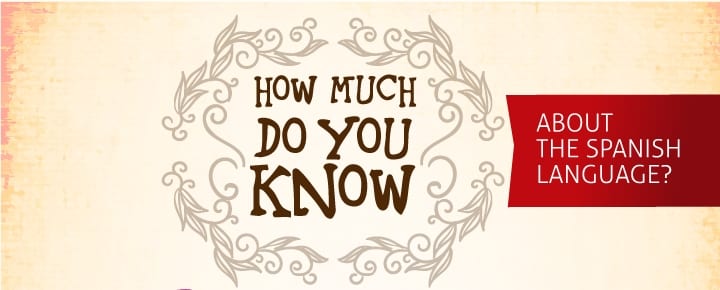Are you ready to learn some fun Spanish language facts? Look no further! From history of Spanish language facts to linguistic facts, this post has everything you could possibly want to know. Plus a fun infographic to hang by your desk as you’re taking Spanish lessons online!
To all linguaphiles, trivia buffs, students, teachers, and world travelers — you probably already know that a country’s language carries many clues about its history, culture, and values. Understanding the intricacies can often make it easier to learn a language, also, since you’ll likely recognize patterns, or how certain language relate to each other.
The Spanish language in particular is really cool to learn about, as you’ll see in this post! We got help from our tutors to compile a list of a whopping 50 interesting facts about the language of Spain, as a way to test your own knowledge.
But first, a few FAQs you should definitely know…
What Are 5 Facts About Spanish?
Here are 5 Spanish facts about the language that you probably didn’t know:
- Many words have completely different meanings depending on what syllable is stressed. For example, la mamá (stressed on the second syllable: the mother), la mama (stressed on the first syllable: the breast).
- There are words in Spanish that cannot be translated in one word in English. An example is empalagar (to feel sick because of too much sweetness in food, but also figuratively, as in romantic situations).
- Spanish is the 2nd most-spoken language as a mother tongue. The number of speakers of Spanish as a first language is almost 399 million.
- Spanish is expected to be the first language of 50% of the population of the United States within 50 years
- The letter ñ is the only Spanish letter of Spanish origins.
One more Spanish language fact you might not know? When you’re learning how to speak Spanish, nailing the Spanish accent can be really, really hard! Here’s a video that will show you how to do it just like a native speaker:
Ready to learn more Spanish language facts? Keep reading for some facts that are sure to delight your friends at your next cocktail party!
What Makes Spanish Language Special?
Spanish is a beautiful language that sounds much like you write it! There aren’t neutral vowels, nasal vowels, or open vowels. It’s an easy language to master, regardless of whether you’re learning how to write, speak, or read Spanish.
Here are two commonly asked questions about the Spanish language – the answers of which are sure to pique your interest and get you ready to learn more Spanish language facts!
Where is Spanish used?
When you think about Spanish speakers, you likely think about Spain and Mexico. But actually, Spanish is the offical language for more than 20 countries — including Cuba, Argentina, Chile, and Nicaragua.
It’s also worth noting that it’s not the ONLY language spoken in Spain. Other official languages of Spain are Galician, Basque, and Catalan.
Who else speaks Spanish?
It’s no wonder that many students, business professionals, and travelers choose to learn Spanish — it’s estimated that almost 400 million people worldwide speak the language! Moreover, being bilingual has tons of benefits.
Not only that, but it’s becoming one of the most widely-spoken second languages in the world.
Spanish Language Facts: The Ultimate Infographic and List of Spanish Fun Facts!
The infographic below showcases the most interesting Spanish language facts we found. See how many of them you already know, and then scroll down to learn even more about the Spanish facts language learners should know!

Share this Image On Your Site
Spanish Grammar & Syntax
The Spanish language isn’t very complex when it comes to its syntax and grammar. Nevertheless, these interesting Spanish language facts about grammar will come in helpful when you’re learning the language!
- If taken literally, the word la persona (person) is feminine, even though it may refer to a man or a woman.[1]
- Nouns that end in -a are usually feminine, but if they start with an a, they take the masculine article el to avoid the combination of the two same vowels (i.e. Spanish speakers say el alma instead of la alma). Still, the word remains being feminine.[2]
- Many words have completely different meanings depending on what syllable is stressed. For example, la mamá (stressed on the second syllable: the mother), la mama (stressed on the first syllable: the breast).
- Spanish has two different verbs that mean “to be” in English: ser and estar. The first one is for permanent states (such as personality features of a person; Yo soy alto [I am tall]) and the second one is for temporary states (such as the location of something; Yo estoy en casa [I am at home]).
- Even though nouns ending in -o are usually masculine, la mano is a feminine word.
- Many nouns are spelled the same but change meanings if they’re used with a different grammatical gender. For example, el cometa (the comet) and la cometa (the kite); el cura (the Catholic priest) and la cura (the cure); el pendiente (the earring) and la pendiente (the slope).[3]
- Different from English, Spanish has a relatively free word order, and variations of the Subject-Verb-Object order occur much more often than in English. For example, the sentence “Juan wrote a book” can be said like “Juan escribió el libro,” “El libro escribió Juan,” “Escribió Juan el libro,” and even “Juan el libro escribió,” or “El libro, Juan escribió” for some literary effect.[4]
- In most parts of the Spanish-speaking world, there’s a familiar-informal 2nd person singular pronoun (usually tú) and a formal 2nd person singular pronoun for unknown, older, or important people (usted).
- In the Rioplatense variety, the pronoun tú is never used; vos is used instead as the informal-familiar 2nd person singular. In some other countries, such as Ecuador, both tú and vos coexist, but the second one has a social connotation and is considered a highly uneducated (and even lowly) way of addressing others.[5]
- Exclamations and questions in Spanish need to begin with an “opening” exclamation mark (¡) or question mark (¿). These punctuation marks do not exist in other languages, except some minority languages in Spain.
- Considering the three moods (Indicative, Subjunctive, and Imperative), there are 17 tenses in Spanish.[6]
- Spanish has two different versions of the imperfect subjunctive that coexist in modern Spanish (Pretérito Imperfecto del subjuntivo), one with -ra endings and one with -se. Most native speakers use either form interchangeably. For instance, the words amara or amase ([if I] loved).
Spanish Pronunciation
Here are some interesting facts about Spanish language pronunciation.
- Spanish is a very phonetic language. If you know how a word is spelled, you can surely know how it’s pronounced.
- If you know how a word is pronounced, you cannot be sure of how it’s spelled.
- Letters b and v sound the same in Standard Modern Spanish (this simplification took place between the 15th and 17th century). Between vowel sounds, they’re pronounced like a soft b, in which the lips don’t touch. This last sound doesn’t exist in English.[7]
- Until the early 18th century, the letter x was used to represent the x sound, like the Scottish word “loch.” After that, it was replaced with the letter j to represent the same sound. For example, the word caja (box) used to be spelled like caxa.[8]
- The letter c, when it appears before the letters e and i, is pronounced differently by speakers in Latin America and Spain. The former pronounce it like an s, whereas the latter pronounce it like th in “the.”
- There are plenty of homophones (words that sound the same but are spelled differently) in Spanish that cause native speakers difficulties in learning how to write. Popular examples are hacia (towards) and Asia (Asia), and hola (hello) and ola (wave).
- Even though the letters y and ll sound slightly different in most parts of Spain and Latin America, in Rioplatense Spanish, the variety spoken in the most populated areas of Argentina and Uruguay sound like “sh” in English. For example, baya (berry) and valla (fence) sound like bah-shah.
- Despite being one of the most common words in the language, the word yo (I) can be pronounced in at least four different ways depending on the location of the speaker.
- The letter y can behave as a consonant at the beginning of syllables (onset), or as a vowel at the ending of syllables (nucleus). For example, yo (y is a consonant), hoy (y has a vowel sound).[9]
10 Spanish Facts About the Vocabulary
Here are 10 facts about Spanish language specifically related to its beautiful vocabulary.
- There are words in Spanish that cannot be translated in one word in English. An example is empalagarse (to feel sick because of too much sweetness in food, but also figuratively, as in romantic situations).[10]
- Another word that cannot be translated in one word is sobremesa (after-dinner conversation).[11]
- Around 8% of Spanish vocabulary is of Arabic origin.[12] Within numerous expressions of casual Spanish conversation, there often exists a strong likeness to Arabic expression. Probably most well-known is the interjection ¡Ojalá!, which is derived from the phrase law šá lláh, meaning “if Allah wills [it].”[13]
- There are 30,500 words that contain all of the vowels (a, e, i, o, u).[14]
The Language of Spain – Culture and History
Here are some Spanish language history facts you’ll be interested to hear!
- Spanish is the 2nd most-spoken language as mother tongue. The number of speakers of Spanish as a first language is almost 399 million.[20] The language with the highest number of native speakers is Chinese with 1.2 billion people.[21]
- Spanish is the 3rd most-used language on the Internet, with 256.8 million users.[22]
- The use of Spanish on the Internet has grown 1,312.4% from 2000 to 2015.[23]
- Spanish is one of the six official languages of the United Nations.[24]
- It is the official language in 22 countries: Argentina, Bolivia, Chile, Colombia, Costa Rica, Cuba, Dominican Republic, Ecuador, Equatorial Guinea, El Salvador, Guatemala, Honduras, México, Nicaragua, Panamá, Paraguay, Perú, Puerto Rico, Spain, Uruguay, and Venezuela.[25]
- Spanish is expected to be the first language of 50% of the population of the United States within 50 years.[26]
- There’s a Spanish-based creole language spoken in the Philippines called Chabacano (poor taste, vulgar). It’s the sole and most extensive Spanish-based creole language that still exists in Asia or Oceania.[27]
- Based on estimates from Census data, the Hispanic population in the US will grow to 132.8 million in 2050.
- People who speak Spanish may call it español (meaning: it comes from Spain), or castellano (meaning: it comes from Castilla, Spain), and many people use both words interchangeably.[29]
- In 1492, the same year when Columbus arrived in America, the first grammar of Spanish was published by Elio Antonio de Nebrija.[30]
- Spanish was the major diplomatic language until the 18th century.[31]
- In 1713, the Real Academia Española was founded. It established authoritative criteria for the sanctioning of neologisms (newly coined words) and the incorporation of international words. Spanish grammar was formalized during this period.[32]
- In present-day Spanish, September may be spelled septiembre or setiembre. However, the latter is considered a vulgar or informal version of the earlier one because of the dropping of sounds. Contrary to popular belief, the word setiembre is the “originally Spanish” word, since until the 17th century there was no agreement in spelling and the “p” was not pronounced.[33]
- Some words that begin with “f” in other Romance languages, begin with “h” in Spanish. This makes such difference a unique development for the Spanish language. For example, ferrum (Latin: iron) and hierro (Spanish: iron); falar (Portuguese: to speak) and hablar (Spanish: to speak); figlio and fumo (Italian: son and smoke) and hijo and humo (Spanish: son and smoke).[34]
- The letter ñ is the only Spanish letter of Spanish origins.[35]
- Beginning in about the 12th century, Spanish scribes (whose job it was to copy documents by hand) used the tilde placed over letters to indicate that a letter was doubled. This resulted in the Latin word annus to be spelled año in Spanish.[36]
- The first written records in Spanish are the Glosas Emilianenses and they date back to 964 A.C.[37]
- The first Literary piece that was fully written in Spanish was “El Cantar de Mio Cid,” which dates back to the 13th century and whose author is unknown.[38]
Is Spanish Hard to Learn?
Here’s one more Spanish language fact that you need to know – learning Spanish is not as hard as you might think.
Taking online lessons can help you become a master of the craft. Consider signing up for some today – and keep practicing until you get the hang of it.
Practice and frequent repetition is the best way to get the hang of a language. Of course, knowing some fun Spanish language facts in Spanish never hurt, either!
Sources
[1] http://www.wordreference.com/es/en/translation.asp?spen=persona
[2] http://www.spanishgrammargenius.com/why_do_i_use_masculine_article_with_feminine_word.htm
[3] http://spanish.about.com/od/nouns/a/double_gendered.htm
[4] http://spanish.about.com/od/sentencestructure/a/word-order-in-spanish.htm
[5] http://deepblue.lib.umich.edu/bitstream/handle/2027.42/86107/Ennis.pdf
[6] http://www.rae.es/diccionario-panhispanico-de-dudas/apendices/modelos-de-conjugacion-verbal
[7] Lapesa, R. (1981). Historia de la lengua española (9th ed.). Madrid: Gredos. pp. 422.
[8] Lapesa, R. (1981). Historia de la lengua española (9th ed.). Madrid: Gredos. pp. 423.
[9] http://clas.mq.edu.au/speech/phonetics/phonology/syllable/syll_structure.html
[10] http://www.wordreference.com/es/en/translation.asp?spen=empalagar
[11] http://www.wordreference.com/es/en/translation.asp?spen=sobremesa
[12] http://people.math.sc.edu/rorabaug/docs/ArabicInfluence.pdf
[13] http://people.math.sc.edu/rorabaug/docs/ArabicInfluence.pdf
[14] http://www.solosequenosenada.com/wp-content/uploads/2010/12/palabras_con_todas_las_vocales_sin_qu_ni_gu.txt
[15] http://dle.rae.es/?id=G9JTupB
[16] http://dle.rae.es/?id=asr6h3K
[17] http://lema.rae.es/drae/srv/search?id=9sxZRrtuiDXX2EHANeeY
[18] http://www.speakinglatino.com/argentine-slang-in-reverse-vesre/
[19] Lapesa, R. (1981). Historia de la lengua española (9th ed.). Madrid: Gredos. pp. 458.
[20] http://www.ethnologue.com/language/spa
[21] http://www.ethnologue.com/language/zho
[22] http://www.internetworldstats.com/stats7.htm
[23] http://www.internetworldstats.com/stats7.htm
[24] http://www.un.org/en/sections/about-un/official-languages/
[25] http://www.nationsonline.org/oneworld/countries_by_languages.htm
[26] http://artsandscience.usask.ca/languages/languages/spanish/
[27] https://www.academia.edu/5922616/Chabacano_The_Case_of_Philippine_Creole_Spanish_in_Cavite
[28] http://www.census.gov/data/tables/2013/demo/2009-2013-lang-tables.html
[29] http://www.wordreference.com/es/en/translation.asp?spen=castellano
[30] http://www.optimnem.co.uk/learning/spanish/language-history.php
[31] http://www.optimnem.co.uk/learning/spanish/language-history.php
[32] http://www.optimnem.co.uk/learning/spanish/language-history.php
[33] Lapesa, R. (1981). Historia de la lengua española (9th ed.). Madrid: Gredos. pp. 390.
[34] http://www.lancaster.ac.uk/staff/letchfoa/comparison/comparison2
[35] http://spanish.about.com/cs/historyofspanish/f/tilde_origins.htm
[36] http://spanish.about.com/cs/historyofspanish/f/tilde_origins.htm
[37] http://www.mecd.gob.es/dctm/ministerio/educacion/actividad-internacional/consejerias/reino-unido/tecla/2005/mayo/20-05-05b.pdf?documentId=0901e72b80b7eb9c
[38] http://www.cervantesvirtual.com/portales/cantar_de_mio_cid/
Suzy S.
![50 Fascinating Facts About the Spanish Language [Infographic]](/_next/image?url=https%3A%2F%2Ftakelessons.com%2Fblog%2Fwp-content%2Fuploads%2F2016%2F01%2FSpanish-Language-Infographic-500x300.jpg&w=3840&q=75)









